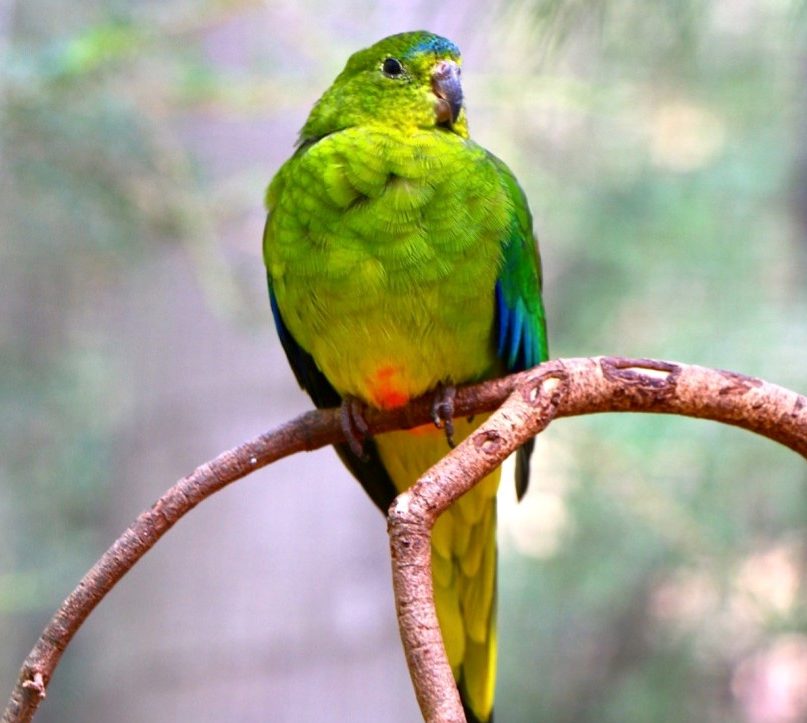Did you know that one of the rarest parrots in the world can be found right here in Victoria? The orange-bellied parrot (OBP) is a small, beautifully coloured ground-feeding parrot slightly larger than a budgerigar. Named for the characteristic bright orange patch on their bellies, these rare parrots are endemic to south-eastern Australia. They are also particularly unique, being one of only two parrot species in the world known to migrate long distances over open ocean.
Wild populations of OBPs breed in Tasmania during the summer seasons (November to March) and fly hundreds of kilometres across rough seas to spend the winter months in the coastal saltmarsh habitats of Victoria and South Australia (April to October). During their northward migration they are also known to visit the saltmarsh coast of King Island.
Although populations are considered stable despite low numbers in Tasmania, they are listed as critically endangered in Victoria, with populations experiencing a severe decline between 2000 and 2008. There is estimated to be as few as 40 to 50 birds left in the wild, with captive breeding programs being the only back-up plan to bolster numbers. The captive breeding populations are estimated to number approximately 320 birds, with the largest located in Taroona, Tasmania and in Healesville Sanctuary, Victoria.
The major cause of their decline is still largely unknown; however, the extreme difficulty of crossing Bass Straight and the major drought of 2007 are thought to be key contributors. Additionally, degradation and loss of saltmarsh winter habitat, and higher prevalence of predators on the mainland are further decreasing wild populations. The birds prefer to stay well away from human disturbances, and are losing more and more habitat due to urban expansion, farming, and grazing by invasive species, such as rabbits. Higher concentrations of feral cats and foxes on the mainland also mean that the non-breeding winter populations are particularly vulnerable to predation. As they are ground-feeding, the birds can be easily targeted whilst feeding on open grassland, seeds and low-lying shrubs.

Although wild populations are continuing to decline, there is still hope for the orange-bellied parrot. The Captive Management Group for the OBP has released captive birds into the wild for the last three years in a row, once every year. The last release of 13 birds occurred in November 2015, just in time for the southward migration back to Tasmania for the breeding season. The biggest challenge of re-stocking the wild population is a loss of genetic diversity and risk of inbreeding. Currently there are geneticists from the Zoo and Aquarium Association keeping records of all captive bird genomes to help determine which birds are to be released.
What can you do to help?
Daniel Gowland, Chairman of the Captive Breeding Management Group, urges the public of Victoria to keep a vigilant eye out for orange-bellied parrots. He emphasises the importance of regular sightings for the success of the Captive Breeding Management Program. As we are now approaching April, the birds should be completing their treacherous journey across Bass Straight and will be currently landing in locations surrounding Melbourne. Now up until November is therefore the prime time for everyone in Victoria to search for these small, elusive parrots.

![Blue-winged parrot. Original image courtesy of David Cook [CC BY-NC 2.0], from Flickr (image in use has been slightly cropped).](https://www.rememberthewild.org.au/wp-content/uploads/2018/05/cropped.jpg)
To lose such a rare and beautiful parrot species would be devastating. On many levels, the current plight of this species unfortunately seems to be a consequence of human expansion and urban development. If we want to continue to enjoy the variety of wildlife within and surrounding the city of Melbourne, we must work together as a community to do anything we can to help save the orange-bellied parrot from the brink of extinction.
Will you be lucky enough to spot one this winter?
Banner image of a captive orange-bellied parrot from Healesville Sanctuary and is courtesy of Lauren Hall.


Leave a Reply